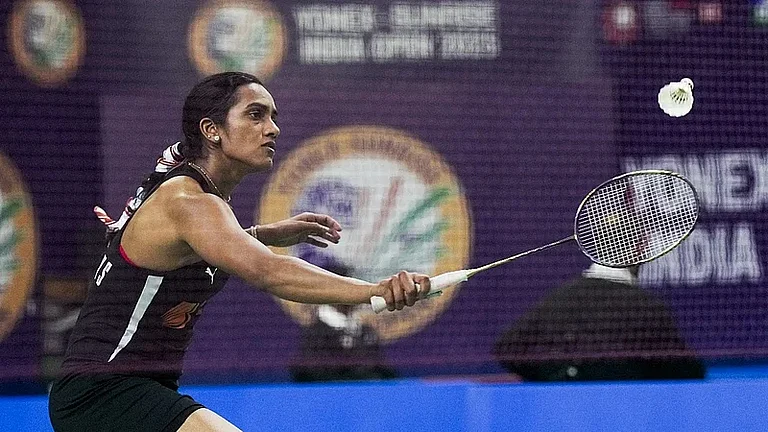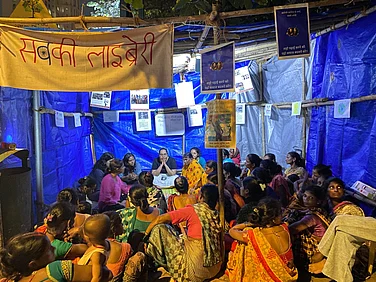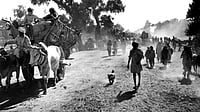When Ardh Satya met Himmatwala: The Many Lives of 1980S' Bombay Cinema
Avijit Ghosh
Speaking Tiger
Rs 599
Like a cat, Bollywood always seems to land on its feet in the most difficult situations. Avijit Ghosh’s latest chronicles the many lives of Bollywood in the 1980s, a decade of clashing tastes, government policies, strikes, understatement, and excesses. The title says it all — a dark police drama Ardh Satya which made a star of Om Puri and the kitschy excess of the action comedy Himmatwala.
Ghosh has put together lists and anecdotes to make a compendium that Bollywood fans and films fans are bound to love. His introduction takes readers through what they are about to expect in Ghosh’s inimitable tongue in cheek style. Rajesh Khanna’s smile made the Sun shine for many. However, Amitabh Bachchan preferred grunts to grins; Bhuvan Shome rose like “a lotus from a pond”; censors are referred to as ‘Scissorhands’, and he refers to his chapters as ‘reels’.
Bombay cinema in the ‘80s swivelled from one end of the spectrum to the other while showing no signs of settling in one direction or the other. The industry was plagued by piracy — so much so that video cassettes were selling on the streets within hours of the first day’s first show and directors and producers were helpless to stop the glut.
As it was, the famed cinema halls suffered from the introduction of television with sports and, gradually, serials, which induced people to watch in the comfort of their homes. The arrival of video cassettes added to this — people became increasingly reluctant to visit cinema halls. Appeals to the government to ban videocassettes achieved no perceptible result —the trade went underground— and was also joined by pirated music from the movies. This was partially aided by vague rules related to the industry as it was possible to create versions of videos and songs without violating copyright. This resulted in the start of the famous T-series, which was so popular that, at one point, Gulshan Kumar’s parallel resources were utilised by Saregama who were unable to produce the numbers of cassettes required for a popular music album.
Some filmmakers, including Shyam Benegal, decided ‘f you can’t beat ‘em, join them’ and went into the serial-making business, drawing criticism from their colleagues who felt that the art was being diluted. Though Benegal’s Bharat Ek Khoj proved a great success, he returned to films.
Censorship of films could be equally arbitrary with censors divided depending on who the filmmaker was. Rehae, on the sensitive subject of coital rights, found a sympathetic woman censor and was passed without a cut. However, Insaniyat ke Dushman went to the courts and back countless times despite the fact that similar subjects on the politician-crime nexus had been passed by the censors with minor cuts. In this film, however, 42 cuts were recommended and the makers fought tooth and nail until the figure came down to 17.
Pushed to the edge by a combination of taxes, censorship, and political bans, the world’s largest film industry went on strike and the cinemas were shut for months while directors, stars, and producers fought for better rights. Ghosh points out that Amitabh Bachchan was absent visiting his children in Switzerland so that the strike was at an impasse for lack of political influence. Ultimately, when he returned, the Big B swung into action and swore to go straight to Rajiv Gandhi if something was not sorted out. It was a sweeping filmy solution, though, in the end, it was not required. Bachchan’s arrival brought about a partial solution and ‘the peace pipe was smoked’ — though piracy and various other issues continued to plague the industry.
Actors complained that Bombay producers rarely paid them upfront and they evolved different strategies for extracting money. This was one of the reasons why South Indian producers gained such traction as they were business-like, paid upfront, and didn’t waste time in unnecessary niceties like hotel rooms if they were not required. They also transformed blockbuster South Indian films into Hindi scripts and surprisingly the format worked on many occasions while heroes like Kamal Haasan became box office draws in Bombay.
Ghosh’s book is a mix of did-you-know’s, bios of actors, dancers, dialogue writers, and lists to dilute the stream of research that he has put into his work. Film fans will love it for the information it delivers and for pieces of trivia like the fact that Govind Nihalani reduced Deepa Sahi to tears with 21 takes of a single shot or that Mithun Chakraborty’s videos were the highest-sellers in Maoist-ridden Dantewada. As the title implies, it is a book of extremes, spanning an often-random time in Bollywood film history with roller coaster effect.

























